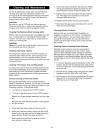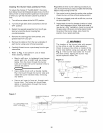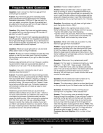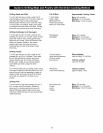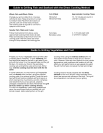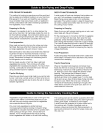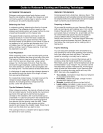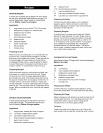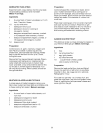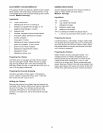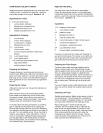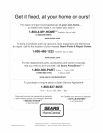Special offers from our partners!

Find Replacement BBQ Parts for 20,308 Models. Repair your BBQ today.

ROTISSERIETECHNIQUES
Rotisseriecookingproducesfoodsthataremoist,
flavorfulandattractive.Althoughtherotisserieismost
commonlyusedforcookingmeatorpoultry,nearly
anythingcanbeusedifpreparedproperly.
Balancing the Food
In rotisserie cooking, balancing the food is of utmost
importance. The rotisserie must turn evenly or the
stopping and starting action will cause the food to cook
unevenly and possibly burn the heavier side.
The easiest foods to balance are those of uniform
shape and texture. To test if the food is balanced
correctly when secured, place the ends of the rotis-
serie spit loosely in the palms of your hands. If there is
no tendency to roll, give the spit a quarter turn. If it is
still stable, give it a final quarter turn. It should rest
without turning in each of these positions. It can then
be attached to your grill.
Food Preparation
When preparing poultry, truss the birds tightly so that
wings and drumsticks are close to the body of the bird.
The cavity of the bird may be stuffed prior to this if you
wish. Pull the neck skin down and, using a small
skewer, fix it to the back of the bird. Push the rotis-
serie spit through lengthwise, catching the bird in the
fork of the wishbone. Center the bird and tighten with
the holding forks. Test the balance as described above.
A rolled piece of meat requires the rotisserie skewer to
be inserted through the center of the length of meat,
then secured and balanced.
For meats that contain bones, it is best to secure the
rotisserie skewer diagonally through the meaty
sections. If protruding bones or wings brown too
quickly, cover with pieces of foil.
Tips for Rotisserie Cooking
When rotisserie cooking, the majority of heat will come
from an indirect source. In other words, the burners at
each end of the grill are lit and the food is placed
centrally on the rotisserie, with no direct heat source
underneath. To catch any drips from the rotisserie food
itwill be necessary to remove the cooking grids and
then place a drip pan directly under the food. These
drippings can be used to make gravies and other
sauces to accompany the cooked meats. Place the lid
down over the food when you start to cook.
The cooking times on a rotisserie will be approximately
the same as for oven cooking.
SMOKING TECHNIQUES
Smoking gives food a distinctive, delicious flavor. This
surprisingly quick and versatile cooking method expands
the creative chef's menu with endless new and innovative
ways to prepare popular barbecue dishes.
Preparing to Smoke
All you need for smoking on your Kenmore Elite gas
grill is a cooking pan and roasting rack. First, line the
inside of the pan with foil. The smoking agent, either
pure wood chips or smoking mix, is sprinkled over the
foil. Dried herbs and spices may also be added to
produce different flavors. Place the cooking pan
directly over the burner. The direct heat will eventually
produce smoke and season the food. Elevate your
food above the cooking pan with a roasting rack or
baking rack.
Tips for Smoking
You can reduce the strength of the smoke flavor by
only smoking for half or three quarters of the cooking
time, then roast your food until done. The heat re-
quired for smoking is normally low to medium.
Foods naturally high in oils lend themselves well to
smoking, while drier foods benefit from a marinade.
Red meats, poultry, game, fish and seafood can all be
smoked easily in your new grill. You can also rub the
food with herbs, spices or flavored oils. An enormous
array of foods can be smoked in your Kenmore Elite
gas grill to produce stunning results with very little
effort. Here are a few suggestions:
• Tuna steaks, marinated in Asian flavors of sesame
oil, soy sauce and sherry.
• Pork fillets, rubbed with ginger, orange rind and
brushed with maple syrup.
• Mussels, brushed with lemon rind and chili oil.
• Lamb cutlets, marinated in virgin olive oil, lemon,
oregano and black pepper. The same marinade can
be used for a whole leg or rack of lamb.
27



